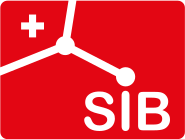Biochemical Pathways and Large Scale Metabolic Networks - August 2016
Section outline
-
Biochemical Pathways and Large Scale Metabolic Networks
Lausanne, 29 August - 2 September 2016
Location: Génopode Building, room 2020
This page is addressed to registered participants. To access the course description and the application form, please click here.
For any assistance, please contact training@sib.swiss.
-
You need to bring a laptop with administrator rights (meaning you can install programs yourself) equipped with:
- a recent browser version
- SSH terminal with X session:
* for Windows: MobaXterm (terminal for Window with X server included). Choose "Installer edition"
* for Mac: a terminal is included but you need to have an X server. You can install XQuartz
for Linux: should be fine
- Java 8 (at least Run Time Environment (JRE), see https://www.java.com, better the full JDK (Java Development Kit) to make sure everything will run).
- A suitable editor for XML:
* for Windows: http://www.winedt.com/ or http://www.heise.de/download/product/easy-xml-editor-39120/download or https://www.microsoft.com/en-us/download/details.aspx?id=7973
* for Mac & Linux have some on board already
The list below contains software that will be used during the practical. They will be accessible from a cluster server, but you can also install them locally if you want:
- Python 2.7 (https://www.python.org/downloads/)
- Java JRE (http://www.oracle.com/technetwork/java/javase/downloads/jre8-downloads-2133155.html)
- COBRApy (https://pypi.python.org/pypi/cobra)
- suds-jurko (https://pypi.python.org/pypi/suds-jurko)
- lxml (https://pypi.python.org/pypi/lxml)
- R (https://cran.r-project.org/)
- sybil (http://cran.at.r-project.org/web/packages/sybil/)
- glpkAPI (http://cran.at.r-project.org/web/packages/glpkAPI/)
- glpk (https://www.gnu.org/software/glpk/) WinGLPK for Windows users (https://sourceforge.net/projects/winglpk/)
- clpAPI (http://cran.at.r-project.org/web/packages/clpAPI/)
- COIN-OR (clp) (http://www.coin-or.org/download/binary/CoinAll/)
Optional:
- RStudio (https://www.rstudio.com/products/rstudio/download2/)
Very optional:
- MatlabIf you have issues with installation, you can contact us
-
Monday 29 August 2016
10:00 - 10:15 Welcome and introduction
Marco Pagni (Vital-IT group, SIB)10:15 - 12:30 Public databases of metabolites, biochemical reactions and enzymes, web-based and programmatic accesses
Kristian Axelsen & Thierry Lombardot (both Swiss-Prot, SIB, Geneva)Details:
- Compounds and reactions as building blocks for metabolic networks
- Compounds: names, isomers, tautomers, charges, structures
- Reactions: balancing
- Enzymes: gene-protein-reaction (GPR) relations12:30 – 13:45 Lunch 13:45 – 15:45 Exercises / hands-on
- Using websites of selected metabolites and reactions databases
- Simple programmatic access using python
15:45 – 16:15 Coffee break 16:15 - 17:15 Biochemical Pathway Representations: Specific Requirements of Genome-Scale Metabolic Networks
Sébastien Moretti (Vital-IT group, SIB, Lausanne)Details:
- What is a metabolic network/model?
- What are model requirements?
- How to compare models? -
Tuesday 30 August 2016
09:00 - 10:30 Introduction to online metabolic pathway databases
Nathan E. Lewis (Systems biochemistry and cell engineering lab, University of California, San Diego) & Andreas Dräger (Systems Biology group, University of Tübingen)10:30 - 11:00 Coffee break 11:00 - 12:30 Exercises / hands-on
Useful software for working with metabolic networks
* Escher for visualization and reconstruction
* KEGGtranslator
practical exercise: reconstruction using online resource lookup12:30 – 13:45 Lunch 13:45 – 15:45 Introduction to constraint-based modeling and Tutorial on COBRApy 15:45 – 16:15 Coffee break 16:15 - 17:15 Reconstruction and simulation of networks
Practical exercise in metabolic engineering using COBRApy/COBRA Toolbox and visualizaion of results and data with Escher -
Wednesday 31 August 2016
09:00 - 10:30 Hybrid Models of Metabolic Networks
Jörg Stelling (Computational Systems Biology Group, SIB & ETH Zurich D-BSSE, Basel)Details:
1. FBA and its variants: Mathematical foundations, linear and non-linear optimization
2. Incorporating experimental data: metabolic flux analysis, integration of -omics data
3. Toward hybrid models: regulatory logig, dynamic FBA10:30 - 11:00 Coffee break 11:00 – 12:30 Continued 12:30 – 14:00 Lunch 14:00 - 17:00 Mini-Symposium
14:00 - 14:40
A hierarchy of decisions that impact the accuracy of tissue-specific metabolic models.
Prof. Nathan E. Lewis
Systems biochemistry and cell engineering lab, University of California, San Diego14:40 - 15:20
Automated generation of realistic models.
Prof. Dr. Jörg Stelling
Computational Systems Biology Group, SIB & ETH Zurich D-BSSE, Basel15:20 - 15:40
Break15:40 - 16:20
Towards a more accurate prediction of the biotransformation of chemical contaminants - What can we learn from combining data mining, analytical chemistry and biology tools?
Dr. Kathrin Fenner
Department Environmental Chemistry, EAWAG, Dübendorf16:20 - 17:00
Gene Ontology: biases, pitfalls, remedies.
Prof. Christophe Dessimoz,
Computational Evolutionary Biology and Genomics, SIB & Department of Ecology and Evolution, University of Lausanne -
Thursday 1 September 2016
09:00 - 10:30 EnviPath - database and prediction system for the microbial biotransformation of organic environmental contaminants
Kathrin Fenner (Department Environmental Chemistry, EAWAG, Dübendorf) & Jörg Wicker (Data Mining Group, Johannes Gutenberg University, Mainz)Details:
1. EnviPath database: environmental contaminants, elements of a pathway, databases, entering an own pathway, exercises;
2. Pathway prediction: brainstorming rules, relative reasoning models, predicting pathways
3. Advanced topics: technical about enviPath DB, interfaces (REST, API), batch processing, training on own relative reasoning model, exercises10:30 - 11:00 Coffee break 11:00 - 12:30 Continued 12:30 – 13:45 Lunch 13:45 – 15:45 The MetaNetX website for genome-scale metabolic network analysis and reconstruction. Usage of R software to analyze and exploit metabolic networks
Marco Pagni, Van Du Tran, Sébastien Moretti (Vital-IT Center for high-performance computing of the SIB Swiss Institute of Bioinformatics, Lausanne)Details:
1. Description and usage of MetaNetX
1a. Automated Model Construction
1b. Transfer of models
2. Integration of transcriptomic data into genome scale metabolic networks:
2a. Genome scale metabolic networks (GSMN): introduction, basic concepts, Sybil R package
2b. Integrating transcriptomics into GSMN: gene expression with RNA-seq data, integration approaches for flux distribution prediction and context-specific GSMN construction
2c. Exercises15:45 – 16:15 Coffee break 16:15 - 17:15 Continued -
Friday 2 September 2016
09:00 - 10:30 Orthology and Comparative Genomics
Christophe Dessimoz (Computational Evolutionary Biology and Genomics, SIB & University of Lausanne)Details:
- Tree thinking and tree inference
- Orthology & paralogy
- Function propagation10:30 - 11:00 Coffee break 11:00 - 12:30 Practical
- Retrieving and interpreting orthologs with OMA
- Optional exercise: inferring phylogenetic trees12:30 – 13:45 Lunch 13:45 – 16:00 Afternoon examination for those wanting ECTS credits

